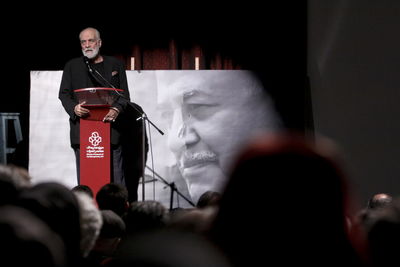Tabrizi was an influential figure in the formation of the Saqqakhaneh School, a neo-traditional style of art that derives inspiration from Iranian folk art and culture.
Speaking at the meeting, Visual Arts Office director Majid Mollanoruzi called Tabrizi an accomplished figure in the history of Iranian art.
“Tabrizi was quite familiar with Iranian classical art such as calligraphy and miniature, while he also made use of Western art in his long professional career,” Mollanoruzi said.
Expressing his condolences to the family of Tabrizi, painter and art critic Aidin Aghdashlu praised Tabrizi for his fighting character.
“The Sadegh Tabrizi that I knew was a quiet and calm person. But over the past few years, during which we hardly saw one another, I thought why has Sadegh become so bitter, what has happened to cause an individual from the world of art who has lived in a society where he was well-known to become so bitter.
“I reviewed those formative years when we grew up. When I review his time, I see him heartbroken, since the one who had exerted great efforts has been ignored, while some minors have grown up and become famous,” Aghdashlu said.
“Tabrizi saw the world in his own way but was upset at being ignored and not respected like others on his own level,” Aghdashlu added.
“It was really hard for me to attend this meeting since walking has become hard for me these days, but I came here to say these few words. I am here to pay my respects to the artist who was among the pioneer artists in Iran. Among those who I knew I can hardly forget Sadegh Tabrizi,” he concluded.
For the first time in 1959, Tabrizi painted and inscribed some illegible words on a ceramic panel, which some experts believe to have been the first calligraphic-painting.
Source: Tehran Times

